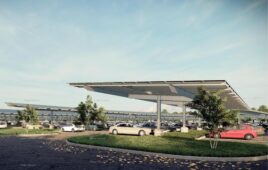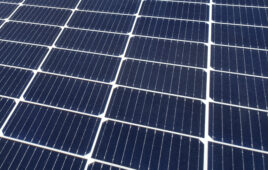Last week, U.S. Sen. Tim Kaine (VA) visited a residential solar customer’s installation after being contacted by installer Ipsun Solar to discuss investment tax credit legislation.
 Ipsun CEO Herve Billiet wrote to Sen. Kaine recently about extending the federal tax credit and adding a direct-pay option for lower-income homeowners who may not owe enough in taxes to benefit from the credit. Sen. Kaine was interested in learning more and asked if he could visit a jobsite to talk with the installer and real customers. SEIA CEO and president Abigail Ross Hopper and Virginia House Delegate Karrie Delaney also joined the visit at a Fairfax home and had a frank discussion in the customer’s backyard.
Ipsun CEO Herve Billiet wrote to Sen. Kaine recently about extending the federal tax credit and adding a direct-pay option for lower-income homeowners who may not owe enough in taxes to benefit from the credit. Sen. Kaine was interested in learning more and asked if he could visit a jobsite to talk with the installer and real customers. SEIA CEO and president Abigail Ross Hopper and Virginia House Delegate Karrie Delaney also joined the visit at a Fairfax home and had a frank discussion in the customer’s backyard.
According to a blog post from Ipsun Solar, Sen. Kaine asked the solar customer why he decided to install a solar + storage system.
“We get a lot of power outages, and after doing some research I learned that I could get a 26% tax credit off the full price of the system if I installed batteries and solar. I wouldn’t get the credit if I had only installed the batteries,” said customer Jim Zuras of Fairfax. The Build Back Better Act, if passed, would allow for a standalone battery tax credit and a direct-pay option.
Ipsun Solar employees also expressed how the tax credits provide a predictability in business that allows for better planning and fewer layoffs.
“We have that 26% tax credit for another year which is great, but it would help so much to extend it for a longer time, and adding that direct pay option for individuals would have a huge impact,” Billiet said. “Direct pay for corporations is nice, but it’s the individual homeowners who don’t have access to other methods of finance like lines of credit. If individual homeowners could have that option to get an immediate refund on the tax credit it would make a huge difference.”
You can read more about the visit on the Ipsun Solar website.





The ITC and before that there were RECs and solar PV rebate programs offered by electric utilities. For instance my first grid tied solar PV system was installed in 2005, the local utility had a “rebate” that was at that time $2.88 for each installed (A.C.) watt. Which means you take the peak solar PV output in D.C. and multiply by the D.C. to A.C. efficiency of the house inverter. At that time my inverter was at about 93% efficiency. In 2005 the Federal tax ‘incentive’ was capped at $2K, so the utility program was the major relief source allowing one to install solar PV on one’s home. IF it was a straight install and pay, in 2005 it would have been an install of $8.45/watt. Today one can find $3/watt to $3.50/watt installed systems without an ITC, prices and affordability are much more reasonable now than in the past.
Right now it’s incoherent laws that are affecting solar installations across the U.S.. Remaining, languishing laws on the books are doing things like, if you have already installed a grid tied solar PV system, you can’t go back and use the ITC to now install battery storage or smart ESS. Then there’s an IF, when a solar PV and energy storage system is installed, you (have) to charge the ESS 80% of the time with D.C. from solar PV only. This abrogates getting a system that is “future ready” when residential solar PV systems will use the ESS as a VPP for grid services and that could include off peak energy storage that would be charged into the ESS in off peak times of the night and used in early morning instead of Peaker plants. Like in California this is why we hear about NEM 3.0 and “stakeholders” going to public meetings and commenting on the “plan”. Trying to get all involved onto the same page is difficult at best. Legislators, principles, utilities and residential ratepayers need to have a comprehensive long range plan of how one adopts, installs and uses their systems is important to all the “stakeholders”.